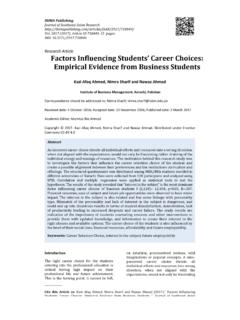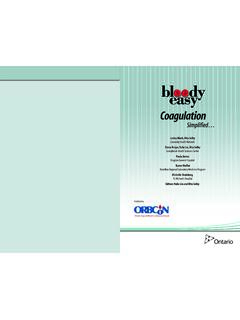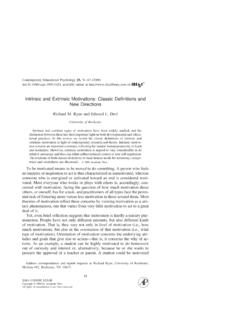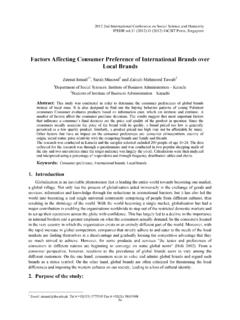Transcription of FACIAL AND PALATAL DEVELOPMENT - Columbia
1 11-1 Letty Moss-Salentijn DDS, PhDDr. Edwin Professor of Dentistry (in Anatomy and Cell Biology) E-mail: ASSIGNMENT: Larsen 3rd edition: ; ; :The external human face develops between the 4th and 6th weeks of embryonic DEVELOPMENT . Facialswellings arise on the frontonasal process (2 medial nasal and 2 lateral nasal processes) and the firstpharyngeal arch (2 mandibular and 2 maxillary processes). By a process of merging and some localizedfusion these processes come together to form the continuous surfaces of the external face. The primarypalate is formed in this period by fusion/merging of the medial nasal and maxillary , between 6th and 12th embryonic/fetal weeks, the secondary palate is formed as the result offusion between PALATAL processes growing from the oral surfaces of the maxillary processes.
2 Eachmerging and fusion site is also the site of a potential FACIAL or PALATAL OBJECTIVES You should be able to:a. Demonstrate on a frontal image of a human face those parts of the face that are formed bycontributions from the frontonasal process and those that are formed by contributions from thefirst pharyngeal Describe the following as to site, composition, time of appearance, and fate: oropharyngealmembrane, oronasal List the derivatives of the four pairs of FACIAL processes and the pair of PALATAL Describe the DEVELOPMENT of the nose and primary Explain the differences between the processes of merging and List all possible sites where FACIAL or PALATAL clefts may develop, and for each indicate what facialor PALATAL processes are Describe the following and list which FACIAL / PALATAL processes participate in their DEVELOPMENT .
3 Primary palate, secondary palate, and definitive Explain the extrinsic and intrinsic factors that may affect the normal DEVELOPMENT of thesecondary FACIAL AND PALATAL DEVELOPMENT11-2 GLOSSARY:Buccopharyngeal membrane. See oropharyngeal Communication between oral and nasal cavities. When posterior to the primary palate: primitive(primary) choana. When posterior to definitive palate: definitive (secondary) palate. The structure that is composed of primary and secondary palate and that separates the fullydeveloped oral and nasal process. Embryonic FACIAL swelling of tissues that cover the surface of the The process by which two FACIAL processes, that were initially separated by a space, grow process. The lower extension of the merged medial nasal processes which will become the philtrumof the upper process.
4 See globular nasal process. An embryonic FACIAL swelling on the frontonasal process, developing lateral to the process. Embryonic FACIAL swelling formed directly by tissues of the first pharyngeal processes. Embryonic FACIAL swelling which is formed as an outgrowth of the proximal part of thefirst pharyngeal nasal process. An embryonic FACIAL swelling on the frontonasal process, developing medial to the The process by which the groove between two FACIAL processes is placodes. Two ectodermal thickenings that appear on the frontonasal process. They are the precursorsof the olfactory membrane. See oropharyngeal membrane. Located posterior to the primary palate, composed of ectodermal layers from fused oraland nasal membrane. A membrane composed of ectoderm and endoderm only which closes off thecephalic end of the developing digestive palate.
5 The structure that is formed by the two maxillary and two medial nasal processes, and thatseparates the developing oral and nasal palate. The structure that is formed by two PALATAL processes (outgrowths of the maxillaryprocesses).TEXT:The human face begins to form during the 4th week of embryonic DEVELOPMENT . By the 6th weekthe external face is completed. Between the 6th and 8th weeks the DEVELOPMENT of the palate subdividesnasal and oral cavities. This DEVELOPMENT continues into the 12th week with completion of the soft of abnormalities throughout a complicated developmental process is inevitable. Theincidence of congenital malformations of the face is approximately 1 in 700 births. This numberincludes major defects incompatible with life and minor defects that are surgically correctable.
6 The mostsevere congenital problems are those that develop early in FACIAL DEVELOPMENT (4th 8th weeks); relativelyminor problems develop later (8th 12th weeks). Clinically, it is important to realize that the tissuessurrounding the forebrain: frontonasal process - see below- develop separately from the tissues of thefirst pharyngeal arch: mandibular and maxillary processes - see below. Therefore you may find adevelopmental problem in one or the other but usually not in both OF THE EXTERNAL FACE - SEQUENCE OF DEVELOPMENTAL EVENTSD uring the third week of DEVELOPMENT an oropharyngeal membrane (buccopharyngeal , or oralmembrane) is first seen at the site of the future face, between the primordium of the heart and the rapidlyenlarging primordium of the brain ( ). It is composed of ectoderm externally and endoderminternally.
7 It lies at the beginning of the digestive tract and breaks down during the fourth week in orderto form the opening between the future oral cavity (primitive mouth or stomodeum) and the foregut. Theoropharyngeal membrane breaks down when it stops growing. While tissues around it expand veryrapidly, the oropharyngeal membrane s non-proliferating cells are gradually pulled apart because theycannot fill the expanding 11-1. Origin of the human face and mouth. The facedevelops from five primordia that appear in the fourth week: thefrontonasal prominence, the two maxillary swellings, and thetwo mandibular swellings. The buccopharyngeal membranebreaks down to form the opening to the oral external face forms from two sources that surround the oropharyngeal membrane ( ): the tissues of the frontonasal process that cover the forebrain, predominantly of neural crestorigin; and the tissues of the first (or mandibular) pharyngeal arch, of mixed mesoderm and neural series of individualized tissue swellings gives rise to the different parts of the face.
8 These areknown as FACIAL processes (prominences). The following FACIAL processes may be recognized ( ):a) the frontonasal process gives rise to: a pair of medial nasal processes (that later contribute to a single globular [intermaxillary] process), and a pair of lateral nasal ) the first pharyngeal arch gives rise to: a pair of mandibular processes (actually the pharyngeal arch itself), and a pair of outgrowths of the arch: the maxillary processes (that later give rise to a pair of PALATAL processes).11-4 Fig. 11-2. The FACIAL region of a 4-week-old human embryo, A, and of a young child, B, are shown, seen from front. The lightlystippled frontonasal process in A, will give rise to forehead, nose, and midsection of upper lip, similarly stippled in B. Themandibular arch darkly shaded in A, will give rise to a large part of the midface and all of the lower face, similarly shaded in 11-3.
9 DEVELOPMENT of the face. A, B, In the sixth week, the nasal placodes of thefrontonasal prominence invaginate to form the nasal pits and the lateral and medialnasal processes. C, D, In the seventh week, the medial nasal processes fuse at the midlineto form the intermaxillary process. E, By the 10th week, the intermaxillary process formsthe philtrum of the upper lip. (A, C, Photos courtesy of Dr. Arnold Tamarin.)11-5 The traditional images of the DEVELOPMENT of the face show the contributions of these differentfacial processes. It is possible to indicate the approximate positions of the boundaries between theseareas. If the processes do not mold together normally during DEVELOPMENT , a congenital malformation,known as a FACIAL cleft, will occur at that the end of the fourth week, two ectodermal thickenings: nasal placodes, appear on thefrontonasal process.
10 They are the precursors of the olfactory epithelium, responsible for the sense ofsmell. During the fifth week, lateral nasal and medial nasal swellings that surround the nasal placodesappear on the frontonasal process. These four nasal processes grow forward, while the nasal placodesremain relatively stationary. This gives the impression that the nasal placodes invaginate . Theyactually stay behind and come to lie in blind nasal pits, surrounded by the nasal processes. This is thefirst step in the DEVELOPMENT of the nasal cavities ( ).Fig. , paired maxillary processes develop near the base of the first pharyngeal arch(mandibular arch). They enlarge and grow ventrally and medially, surrounding the future oral cavity. Themaxillary processes grow rapidly, first meeting the lateral nasal processes, and then the lower extensionof the medial nasal processes.



















